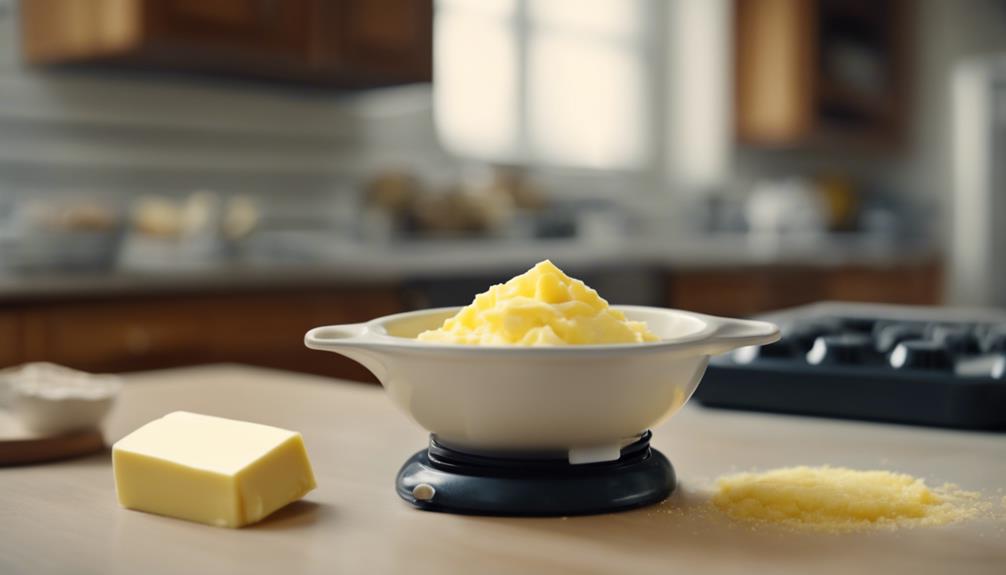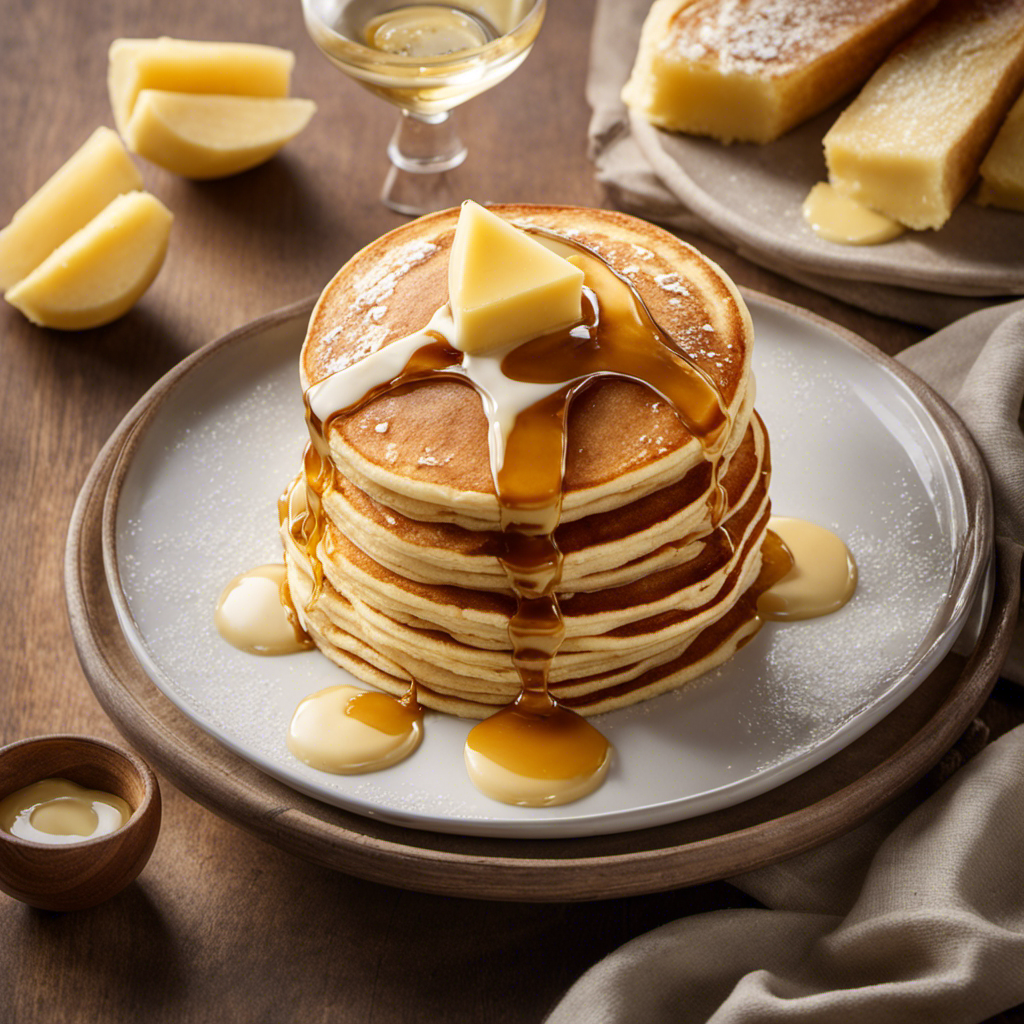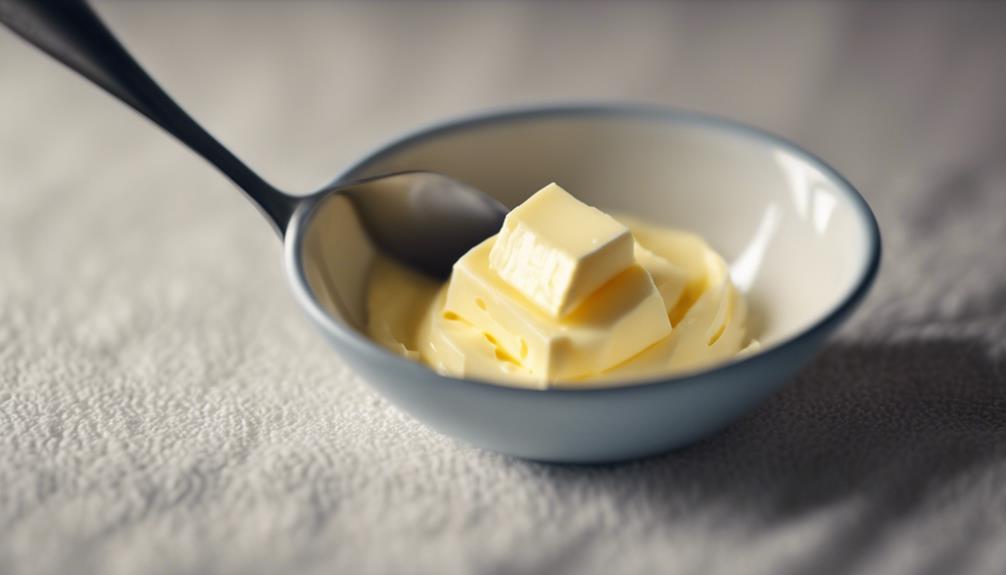You can whip up tasty edible cookie dough without using butter by opting for plant-based alternatives. Start by heat-treating your flour for safety. Then, mix flour, granulated or brown sugar, plant-based milk, and vanilla extract until smooth. Add vegan chocolate chips for extra delight. If the dough's too thick, adjust with more plant-based milk. Store the dough in the fridge and bring it to room temperature before serving. Curious about adding unique flavors or ensuring it's perfectly creamy? There's plenty left to uncover!
Key Takeaways
- Substitute butter with vegan alternatives like margarine, coconut oil, or avocado for a smooth, creamy texture.
- Heat-treat flour to ensure it's safe for raw consumption before mixing it with other ingredients.
- Use plant-based milk to adjust the dough's consistency to achieve a perfect creamy and smooth texture.
- Store the raw cookie dough in airtight containers in the fridge or freezer to maintain freshness and safety.
- Customize your dough with vegan-friendly mix-ins like chocolate chips, nuts, or peanut butter for added flavor and texture.
Ingredients Needed
To make edible cookie dough without butter, you'll need a variety of vegan-friendly ingredients. Start with a base of flour, making sure it's safe for consumption since you'll be eating the dough raw.
For the fat component, you can use coconut oil, margarine, or even mashed avocado as a healthier option. These substitutes work well to create a dough that's both creamy and delicious.
You'll also need plant-based milk to achieve the right consistency. Almond milk, oat milk, or soy milk are great choices that won't compromise taste or texture. Add a touch of vanilla extract for flavor.
Sweeten your dough with either granulated sugar or brown sugar. The latter adds a richer, caramel-like flavor, enhancing the overall taste.
Don't forget the vegan chocolate chips; they're essential for making your dough indulgent without needing dairy-based ingredients.
Mix these ingredients together, and you've got a batch of vegan, edible cookie dough that's perfect for snacking or as a base for other treats. This dough can be enjoyed raw or even baked into cookies if you prefer.
Enjoy your delicious, dairy-free creation!
Heat-Treating Flour
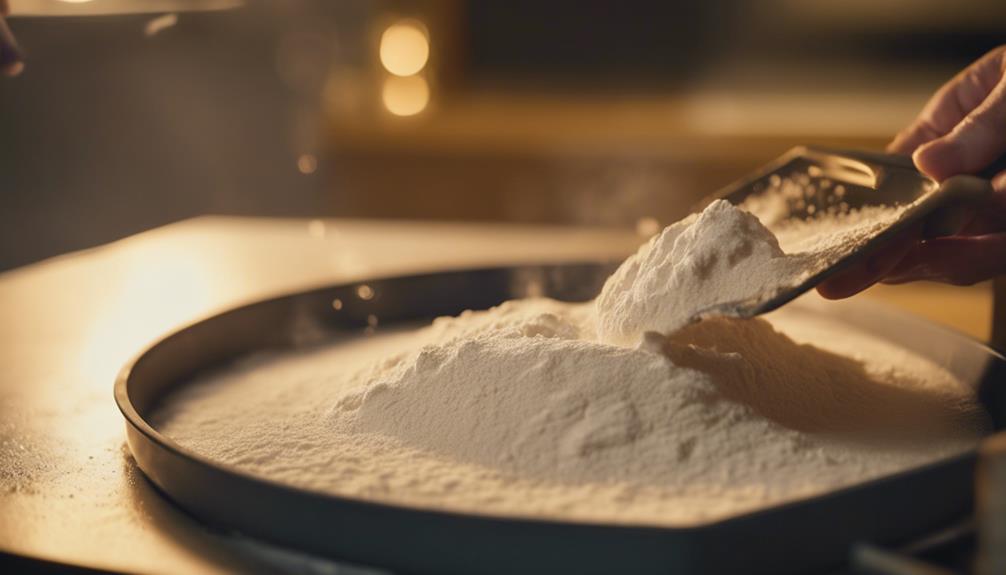
Heat-treating the flour makes certain that any harmful bacteria are eliminated, ensuring it's safe for raw consumption. To heat treat the flour, you can either microwave it for 45-60 seconds or bake it in the oven for about 5 minutes. This vital step guarantees that your vegan cookie dough recipe is safe to consume, particularly since raw flour can harbor harmful bacteria.
When creating edible vegan cookie dough, it's crucial to heat treat the flour to remove any potential health risks. Whether you're using vegan butter or another substitute, properly heat-treated flour is a fundamental element in crafting a delightful and safe treat. Without this step, the raw flour in your dough could present a health hazard.
To begin, spread the flour evenly on a baking sheet if you're using the oven method, or place it in a microwave-safe bowl for the microwave method. Ensure it reaches a temperature of at least 165°F to eliminate any bacteria.
Mixing the Dough
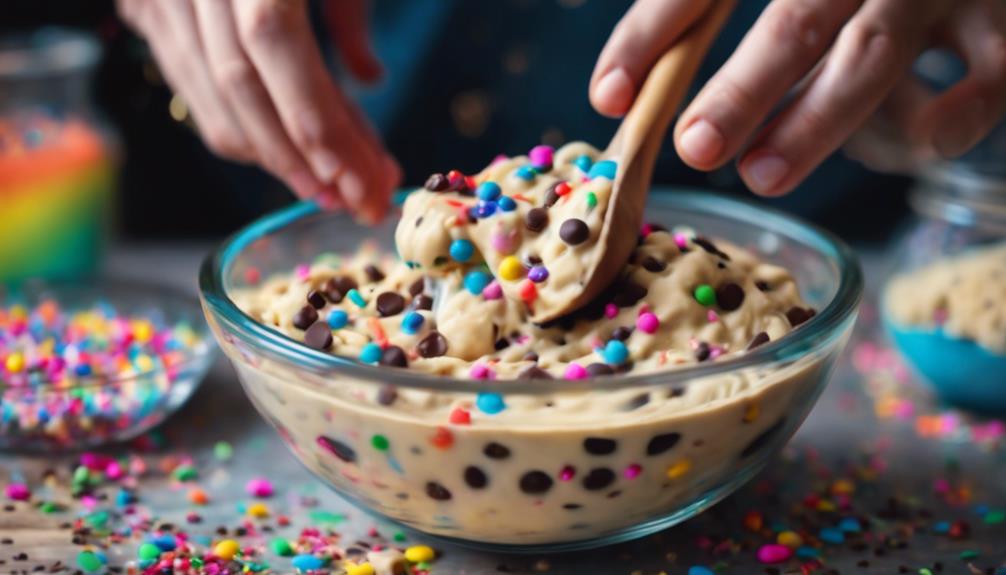
When mixing the dough, you'll want to achieve the perfect consistency by combining vegan butter, sugars, and vanilla until creamy.
Gradually add the flour, and if the mixture is too thick, adjust with a bit of plant-based milk.
Don't forget to stir in vegan chocolate chips for that extra touch of sweetness.
Achieving Perfect Consistency
Gradually blend in plant-based milk, using a spatula or wooden spoon, until the dough reaches your desired texture. The key to achieving that ideal cookie dough consistency lies in how you incorporate the milk. Start with a small amount and mix it thoroughly before adding more. This careful approach guarantees that the dough doesn't become too runny or too stiff.
As you mix, use the spatula to scrape the sides and bottom of the bowl to make sure all the ingredients are evenly distributed. This technique helps maintain a uniform texture throughout the dough. Stir gently to avoid overmixing, which can make the dough tough or dense.
Monitor the consistency closely. If you prefer a softer dough, add a little more plant-based milk, one tablespoon at a time. For a firmer texture, reduce the amount of milk you add. Remember, the goal is a smooth and creamy edible cookie dough that holds together well without being overly sticky or dry.
Achieving the perfect consistency might require a bit of patience, but the result is a delicious, butter-free treat that's perfect for any occasion. Happy blending!
Incorporating Vegan Alternatives
Why not elevate your cookie dough by incorporating vegan alternatives that bring both flavor and texture to the mix? Start by swapping traditional butter with plant-based butter like vegan butter or coconut oil. These options will give your dough a rich texture without any dairy. Next, use non-dairy milk such as almond milk, soy milk, or oat milk to achieve a creamy consistency.
For extra flavor, mix in vegan-friendly ingredients like dairy-free chocolate chips, cacao nibs, or dried fruit. These add-ins guarantee your dough is both delicious and cruelty-free. Sweeten your dough with alternative sugars like coconut sugar, maple syrup, or agave nectar. These natural sweeteners not only taste great but also offer a healthier option.
Lastly, experiment with gluten-free flour options to create a suitable vegan cookie dough recipe. Almond flour, coconut flour, or oat flour are excellent choices that maintain the dough's structure while keeping it gluten-free.
Here's a quick reference table:
| Ingredient Type | Traditional Option | Vegan Alternative |
|---|---|---|
| Butter | Dairy Butter | Plant-based butter (vegan butter, coconut oil) |
| Milk | Cow's Milk | Non-dairy milk (almond, soy, oat) |
| Sweeteners | White Sugar | Alternative sugars (coconut sugar, maple syrup, agave nectar) |
| Add-ins | Milk Chocolate Chips | Dairy-free chocolate chips, cacao nibs, dried fruit |
| Flour | All-purpose Flour | Gluten-free flour (almond, coconut, oat) |
Adding Chocolate Chips
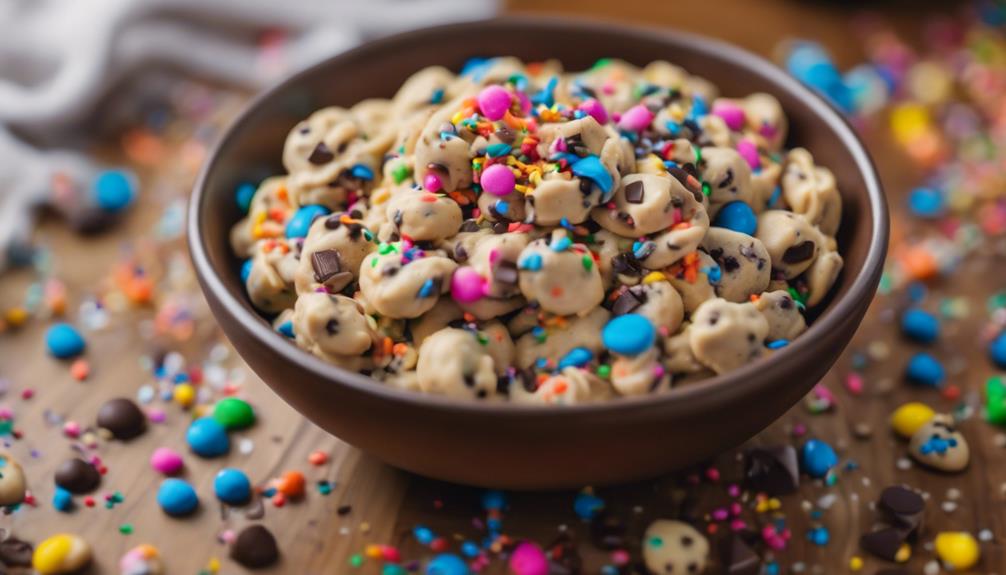
When adding chocolate chips, you can choose vegan options for a plant-based treat.
Be sure to mix the dough thoroughly to guarantee an even distribution of the chocolate, giving every bite a burst of sweetness.
Opt for dark chocolate chips if you prefer a richer flavor profile.
Choosing Vegan Chocolate Chips
To elevate your edible cookie dough, choose vegan chocolate chips that are labeled as 'dairy-free' or 'vegan'. These are ideal for anyone following a plant-based diet because they don't contain any animal ingredients. Despite being free of dairy, they offer the same delightful taste and texture as traditional chocolate chips. You won't have to compromise on flavor; vegan chocolate chips provide a rich, indulgent experience that enhances your cookie dough without any guilt.
When selecting your vegan chocolate chips, you'll find a variety of options to suit your taste. Whether you prefer dark chocolate, semi-sweet, or even white chocolate alternatives, there's something for everyone. These choices guarantee that your cookie dough will have that classic, indulgent flavor while staying true to your dietary preferences.
Moreover, opting for dairy-free chocolate chips means you're making a more compassionate choice. By avoiding animal ingredients, you're contributing to a more sustainable and ethical food system.
Mixing for Even Distribution
Stir the chocolate chips into your cookie dough to ensure every bite bursts with well-balanced sweetness. Start by adding a generous amount of chocolate chips to your dough. The main point here is mixing thoroughly. You want to achieve an even distribution so that each spoonful offers the same delightful flavor and texture.
When mixing, make sure that the chocolate chips are spread evenly throughout the dough. This step is vital because uneven distribution can result in some bites being overly sweet while others lack that chocolatey goodness. Use a spatula or wooden spoon to fold the chocolate chips into the dough, ensuring to scrape the sides and the bottom of the bowl for the best results.
The type of chocolate chips you choose can also impact the flavor and texture of your edible cookie dough. Whether you opt for semi-sweet, dark, or even white chocolate chips, each variety will bring its own unique sweetness and texture to the mix. So, don't hesitate to experiment to find your perfect combination.
Adjusting Consistency

Fine-tune the consistency of your edible cookie dough by gradually adding small amounts of plant-based milk until you achieve the perfect texture. The key to delicious vegan cookie dough lies in the balance of ingredients, ensuring a creamy and smooth mixture that's perfect for shaping or serving. Start by mixing your base ingredients and slowly incorporate the plant-based milk. This helps you avoid a runny dough, maintaining a slightly sticky but manageable consistency for your cookies.
Consistency adjustments are essential for creating that ideal texture. The dough should be creamy enough to enjoy on its own or as a delightful topping for other desserts. As you mix, focus on the texture you're aiming for—smooth and easy to handle. If it feels too dry, add a tiny bit more milk and mix thoroughly.
Here's a quick emotional guide to help you through the process:
| Feeling | Action | Result |
|---|---|---|
| Excited | Add a splash of milk | Creamy, dreamy dough |
| Anxious | Mix slowly | Perfectly balanced texture |
| Happy | Shape into balls | Fun, enjoyable cookies |
Storage Tips
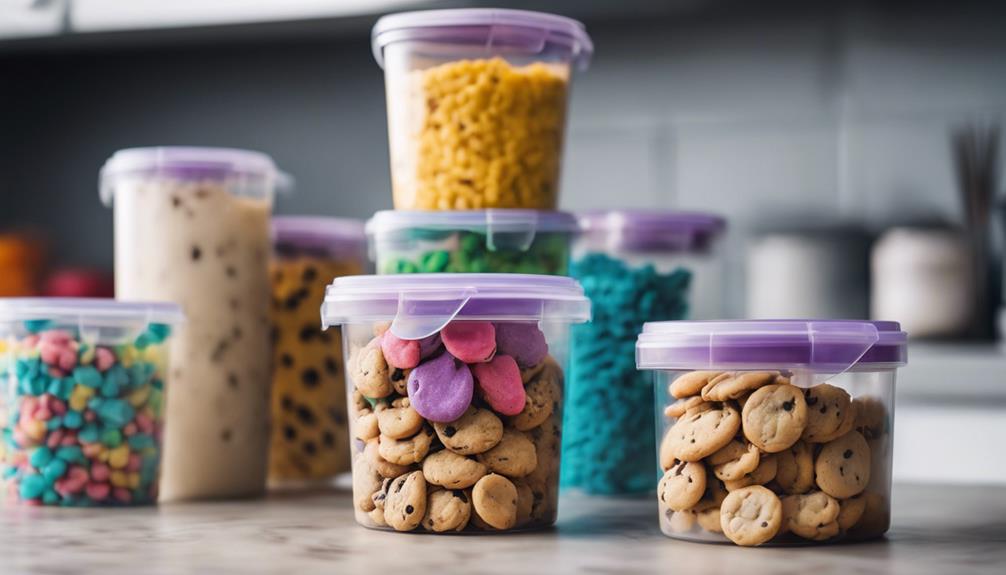
Once you've perfected the consistency, knowing how to store your edible cookie dough will guarantee it stays fresh and safe to eat. First, always store raw cookie dough in the fridge. It'll stay good for up to five days.
If you want to keep it longer, consider freezing it. Portioning the dough into bite-sized balls before freezing is a great idea. This way, you can easily grab a quick treat without defrosting the entire batch. Frozen cookie dough can last up to six months.
Before indulging, let the dough sit at room temperature for a bit. It makes it easier to enjoy and enhances the texture. Another important step for your safety is heat treating flour. Raw flour can harbor harmful bacteria, but baking it at a high temperature before using ensures it's safe.
Proper storage is vital for extending the shelf life of your edible cookie dough. Use airtight containers to prevent it from drying out or absorbing other fridge odors.
Following these storage tips not only preserves the freshness but also guarantees every bite is as delicious as the first. Enjoy your sweet treats with confidence!
Recipe Variations

Experimenting with recipe variations allows you to customize your edible cookie dough to suit different dietary needs and flavor preferences. For a vegan cookie dough, opt for alternative sugars like stevia or date sugar. These not only provide a different flavor profile but also cater to those avoiding traditional sugars.
If you're looking for gluten-free options, try using flour substitutes such as almond flour or coconut flour. These alternatives can change the texture and taste, making your cookie dough unique. Adding mix-ins like vegan candies, sprinkles, or chopped nuts can elevate your dough with extra texture and flavor.
For a richer, nuttier taste, consider incorporating a tablespoon of peanut butter into your mix. This simple addition can transform your dough into a delightful, nutty treat. If you're a fan of classic flavors, you can create vanilla cookies by omitting the chocolate chips and adding a splash of vanilla extract instead.
These variations make it easy to tailor your cookie dough recipe to your specific preferences, ensuring you have a delicious and personalized treat every time. So, don't hesitate to mix things up and find your perfect combination!
Common Questions
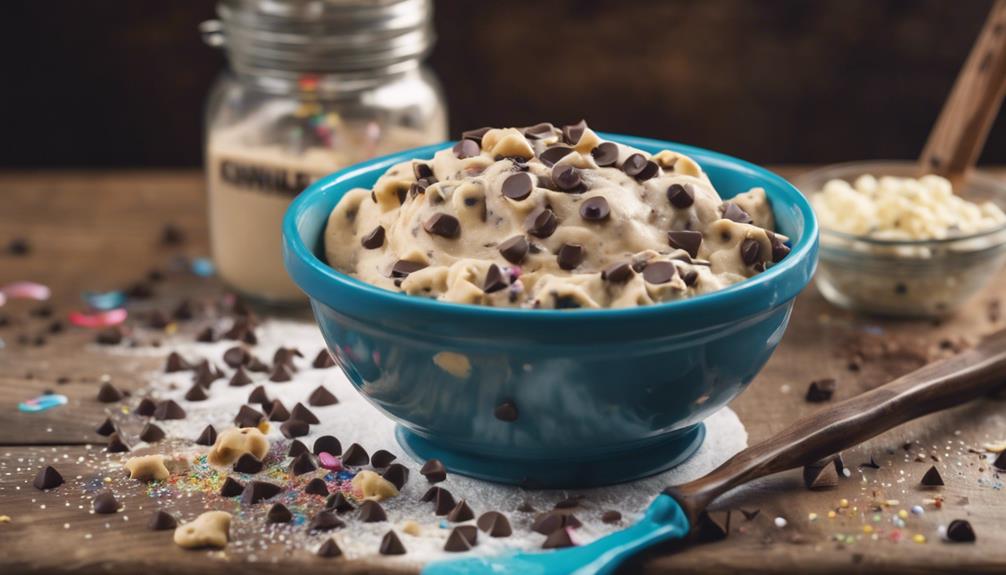
A common question about making edible cookie dough without butter is how to achieve the right texture and flavor with alternative ingredients. When swapping out traditional butter, you have a couple of excellent options: vegan butter and coconut oil. Both offer a smooth, rich consistency that closely mimics butter but with a dairy-free twist.
- Ingredient substitutions:
Using vegan butter or coconut oil can give you a similar base for your cookie dough. Vegan butter tends to have a closer texture to traditional butter, while coconut oil can impart a slight coconut flavor, adding an interesting twist.
- Texture adjustments:
If your dough feels too dry, adding a splash of plant-based milk (like almond or oat milk) can help achieve the perfect consistency. On the flip side, if it's too wet, a little extra flour can balance it out.
- Taste comparisons:
You might notice subtle differences in flavor. Vegan butter typically has a neutral taste, making it a perfect stand-in for butter. Coconut oil, however, adds a light coconut flavor, which some find delightful.
Serving Suggestions
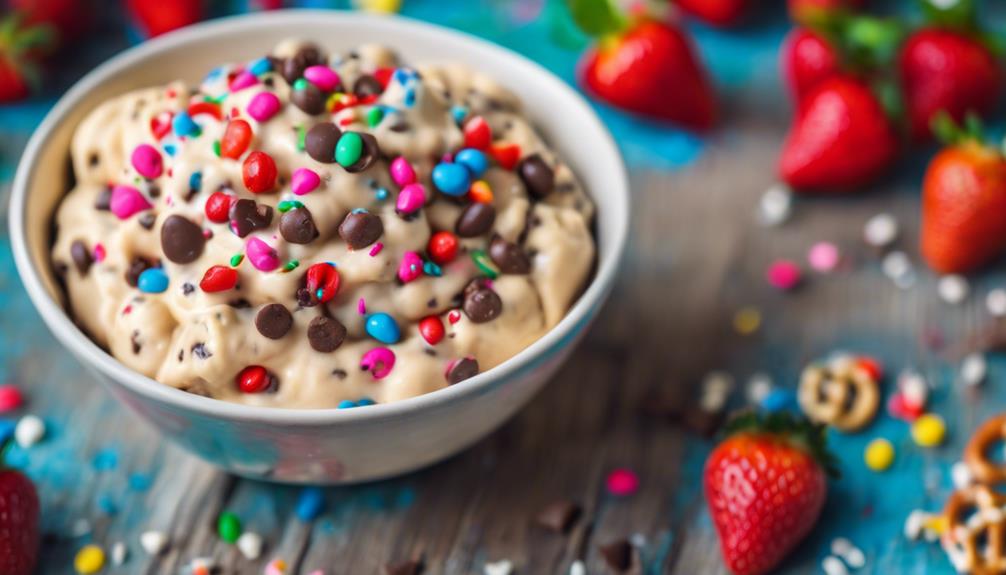
Enjoy your vegan edible cookie dough straight from the bowl or get creative with these fun serving suggestions. You can savor this sweet snack as it is, perfect for a quick indulgence at any time of the day.
For a delightful twist, use the cookie dough as a topping for ice cream, yogurt, or oatmeal. It adds a sweet and chewy texture that elevates your favorite desserts and breakfast dishes.
Incorporate the vegan edible cookie dough into baked goods like brownies, cupcakes, or cookies for a unique spin on traditional recipes. Imagine biting into a brownie with pockets of delicious cookie dough or enjoying a cupcake with a cookie dough center. It's a simple way to impress friends and family with your baking skills.
If you're looking for a thoughtful and delicious homemade gift idea, consider presenting the cookie dough in jars or gift bags. Decorate them with ribbons and personalized labels to create a charming and tasty treat that anyone would love to receive.
Whether as a midday snack, a topping for your favorite desserts, or a special addition to baked goods, this vegan edible cookie dough is versatile and delicious.
Nutritional Information
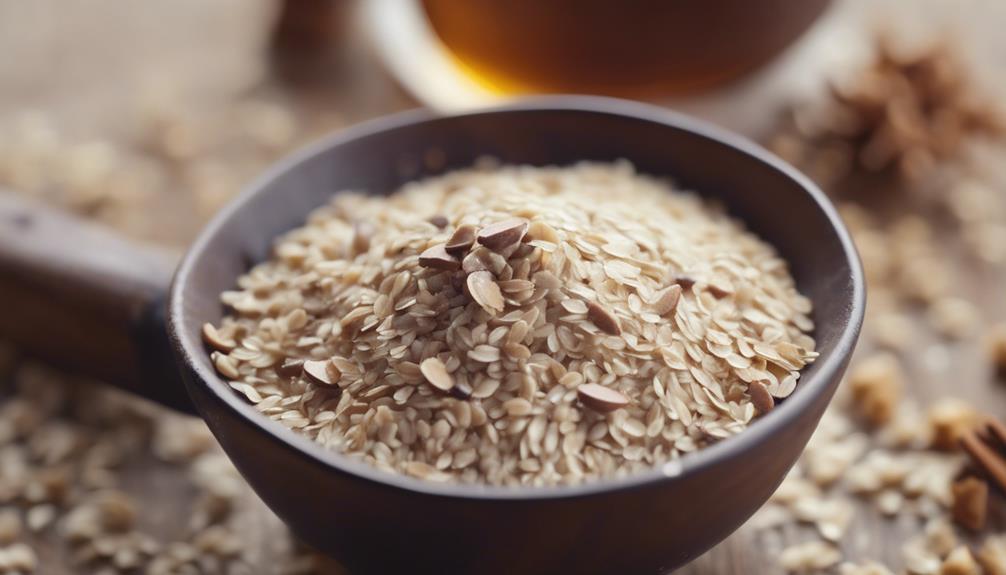
Understanding the nutritional information of vegan edible cookie dough helps you make informed choices about your indulgences. Each serving of this tasty treat contains approximately 483 calories, making it a rich and satisfying option. Knowing what's in your dessert can guide you in balancing your diet and maintaining your health goals.
Here's a quick breakdown of the nutritional components:
- Carbohydrates: Each serving provides 34g of carbohydrates, offering a quick energy boost.
- Protein: With 10g of protein per serving, this vegan cookie dough contributes to your daily protein intake.
- Fat: A single serving contains 36g of fat, including 14g of saturated fat, which adds to its creamy texture and indulgent flavor.
While the vegan cookie dough is delicious, it's crucial to enjoy it in moderation due to its high calorie and fat content. The 36g of fat per serving, including the 14g of saturated fat, contributes significantly to its rich taste.
Balancing these indulgences with healthier meals throughout the day can help you maintain a well-rounded diet. By understanding the nutritional information, you can savor your vegan cookie dough while staying mindful of your overall intake.
Frequently Asked Questions
What Can Be Used as a Substitute for Butter in Edible Cookie Dough?
You can use vegan butter, coconut oil, or plant-based margarine as substitutes for butter in edible cookie dough. These alternatives offer a similar texture and binding properties, with coconut oil adding a subtle flavor boost.
What Can You Substitute for Butter When Making Chocolate Chip Cookies?
You can substitute butter in chocolate chip cookies with coconut oil, creamy cashew butter, or mashed bananas. Each option offers a unique texture and taste, transforming traditional treats into tantalizingly tasty treasures. Experiment for delightful diversity!
Can I Use Oil Instead of Butter in Cookies?
Yes, you can use oil instead of butter in cookies. Coconut oil, olive oil, or vegetable oil work well. Just adjust the amount and consider the oil's flavor profile and smoke point to get the best results.
What Happens if You Don't Put Enough Butter in Cookie Dough?
Did you know that 80% of a cookie's moisture comes from butter? If you don't put enough butter in cookie dough, you'll end up with dry, crumbly cookies lacking in flavor and richness. Balance is essential!
Conclusion
You've now got the know-how to whip up delicious, butter-free edible cookie dough! Did you know that 52% of cookie dough lovers prefer eating it raw over baked cookies?
So, go ahead and indulge without worry. Whether you're craving a sweet treat or looking to impress guests, this recipe's got you covered.
Enjoy your cookie dough straight from the bowl or add it to ice cream for an extra treat.
Happy snacking!

